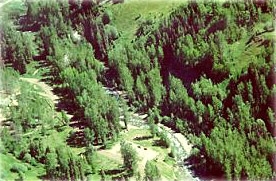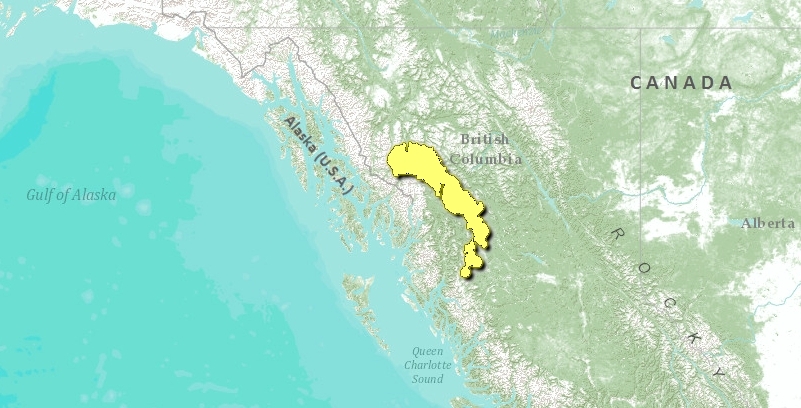Northern transitional alpine forests
This small ecoregion in west central British Columbia lies just east of the coastal mountains in southernmost Alaska.
The transitional alpine forests climate is characterized as moist montane southern Cordilleran. The ecoregion is generally very wet, and precipitation ranges from 2,500 millimeters (mm) in the western coastal areas of the Nass River valley to 600 mm in the lower elevations of the interior Bulkley ranges. Temperature varies widely according to elevation, but rests between 13°C in the summer and -9.5°C in the winter.
This ecoregion consists of the transitional physiography between the rugged and massive coastal ranges and the more subdued Omineca mountains in the east. It is largely underlain by folded Jurassic and Cretaceous sediments, but there is extreme variation in elevation, ranging from the high, mountainous, and heavily glacierized areas of the Hazelton and Skeena Mountains (2,500-2,800 meters (m) above sea level), to the low Nass and Skeena River Valleys (less than 750 m above sea level). In the western portion of the ecoregion, these valleys are broad and gently rolling in the lower elevations, but they are increasingly deeply incised and steep as one moves east into the Skeena Mountains, and away from the Nass Basin. The westernmost portion of the ecoregion contains several large, elongated lakes, which drain into the eastern interior of British Columbia. There are also isolated patches of permafrost in some of the higher elevations of the Skeena Range.
Biological Distinctiveness
Moist montane areas (low elevation valley systems), particularly in the west, are dominated by western red cedar (Thuja plicata) and western hemlock (Tsuga heterophylla), and mountain hemlock (T. mertensiana) in the wetter lower subalpine. Lodgepole pine (Pinus contorta), Engelmann spruce (Picea engelmannii), and alpine fir (Abies lasiocarpa) dominate the subalpine throughout the ecoregion, although to a lesser extent as one nears the coast. The alpine vegetation is typically tundra (Biome), and includes discontinuous patches of low-growing heather (Ericaceae), sedge (Carex spp.), and mountain avens (Dryas hookeriana).
Grizzly bear (Ursus arctos), black bear (U. americanus), moose (Alces alces), red fox (Vulpes vulpes), and wolf (Canis lupus) range throughout the ecoregion, and parts are populated by woodland caribou (Rangifer tarandus spp. caribou), snowshoe hare (Lepus americanus), marten (Martes americana), beaver (Castor canadensis), grouse (Dendragapus spp.), and black-tailed deer (Odocoileus hemionus). Higher elevations support mountain goat (Oreamnos americanus) and wolverine (Gulo luscus) and ptarmigan (Lagopus spp.) can be found in the eastern ranges.
Among important ecological phenomena, the ecoregion supports a high density of grizzly bear and continues to have healthy salmon populations (Oncorhynchus spp.). Populations of mountain goat are found in the Bulkley Ranges. In addition, an unusual wet temperate rainforest, transitional between the coast and interior forests, exists in this ecoregion.
Conservation Status
Habitat Loss
It is estimated that approximately 75 percent of this ecoregion remains as intact natural habitat. Most of the remaining habitat has been altered by logging, particularly in the major valleys. Mineral exploration is occurring in the alpine and subalpine habitats and a major transportation corridor separates the Bulkley Ranges from the Babine Ranges.
Remaining Blocks of Intact Habitat
- Babine Mountains - northwest central British Columbia - alpine and subalpine habitat.
- Bulkley Ranges - northwest central British Columbia - alpine and subalpine habitat used by mountain goats/caribou.
- Muckaboo Creek - northwest central British Columbia - temperate rainforest with grizzly bears/salmon habitat.
Degree of Fragmentation
Most of this mountainous ecoregion remains intact. Some habitat is naturally fragmented due to the distribution of mountain blocks separated by fast-flowing rivers. Additional habitat fragmentation has occurred as the result of clearcut logging in some of the valleys and a major transportation corridor in the Burkley Valley.
Degree of Protection
- Babine Mountains Provincial Park - northwest central British Columbia - 324 square-kilometers (km2)
- Ningunsaw River Ecological Reserve - northwest central British Columbia - 20.46 km2
Types and Severity of Threats
Threats are high for this ecoregion. All remaining forests (including temperate old-growth) are slated to be cut in the next 60 years. As low elevation areas are encroached upon for logging, access is becoming a concern as logging roads open up remote areas where ungulates such as caribou are present. Loss of low elevation forests creates significant habitat loss for both permanent low elevation species and others that use these areas as critical winter habitat.
Suite of Priority Activities to Enhance Biodiversity Conservation
- Additional protected areas need to be established in alpine and subalpine [[habitat]s] to protect mountain goat and caribou habitat. A protected area candidate needs to be established in the Muckaboo Creek area to conserve temperate rainforest with prime grizzly bear and salmon habitat.
- The Babine River corridor needs to be better protected.
Conservation Partners
- Canadian Parks and Wilderness Society, British Columbia Chapter
- The Nature Conservancy, British Columbia
- Nechako Environmental Society
- Northwest Wildlife Preservation Society
- Prince George Naturalists
- Williams Lake Environmental Society
- World Wildlife Fund Canada
Relationship to Other Classification Schemes
This ecoregion covers the western portion of the Skeena Mountains and the Bulkley Ranges in the far south (TEC 198 and 201). The Bulkley Ranges have an elevation of up to 2,500-2,800 m above sea level. Montane Transition (4), Interior Subalpine and Tundra (Biome) forest types are found in this ecoregion.
| Disclaimer: This article is taken wholly from, or contains information that was originally published by, the World Wildlife Fund. Topic editors and authors for the Encyclopedia of Earth may have edited its content or added new information. The use of information from the World Wildlife Fund should not be construed as support for or endorsement by that organization for any new information added by EoE personnel, or for any editing of the original content. |

